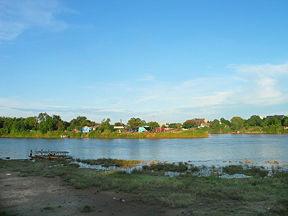Chao Phraya River
| Chao Phraya River | |
|---|---|
 |
|
| Origin | Confluence of Ping River and Nan River |
| Mouth | Gulf of Thailand |
| Basin countries | Thailand |
| Length | 372 km (231 mi) |
| Avg. discharge | 883 m³/s |
| Basin area | 160,000 km² (141,398 mi²) |

The Chao Phraya (Thai: แม่น้ำเจ้าพระยา) is a major river in Thailand, with its low alluvial river plain marking the mainland of the country.
Contents |
Etymology
According to many European old maps, the river is named as Menam or Mae Nam, the Thai word for river (Me or Mae is "Mother", Nam is "Water"). The name Chao Phraya is a Thai feudal title, which can be translated as General or Lord. In the English-language media in Thailand the name is often translated as River of Kings.
Geography
The Chao Phraya begins at the confluence of the Ping and Nan river at Nakhon Sawan (also called Pak Nam Pho) in the Nakhon Sawan province. It then flows from north to south for 372 km from the central plains to Bangkok and the Gulf of Thailand. In Chainat, the river splits into the main river course and the Tha Chin river, which then flows parallel to the main river and exits to Gulf of Thailand the about 35 km west of Bangkok in Samut Sakhon. In the low alluvial plain which begins below the Chainat dam, many small canals (khlong) split off from the main river. The khlong are used for the irrigation of the region's rice paddies.
River Settlements

The cities along the Chao Phraya are Nakhon Sawan, Uthai Thani, Chainat, Singburi, Ang Thong, Ayutthaya, Pathum Thani, Nonthaburi, Bangkok and Samut Prakan, listed from north to south. These cities are among the most historically significant and densely populated settlements of Thailand precisely because of their access to the waterway.
Notable Bridges
- Rama VI, rail-road bridge of the southern line
- Phra Pin-klao, near Grand Palace
- Rama VIII, a single tower asymmetrical cable-stayed bridge
- Rama IX, semi-symmetric cable-stayed bridge
- Mega Bridge, part of Industrial Ring Road
Transportation
In Bangkok, the Chao Phraya is a major transportation artery for a vast network of ferries and water taxis, also known as longtails.
- See also: Chao Phraya Express Boat
Tributaries
The principal tributaries of the Chao Phraya River are the Pa Sak River, the Sakae Krang River, the Nan River (along with its principal confluent the Yom River), the Ping River (with its principal confluent the Wang River), and the Tha Chin River.[1][2][3] Each of these tributaries (and the Chao Phraya itself) is further tributed by additional minor tributaries often referred to as khwae. All of the tributaries, including the lesser khwae, form an extensive tree-like pattern, with branches flowing through nearly every province in central and northern Thailand.[1] None of the tributaries of the Chao Phraya extend beyond the nation's borders.[4] The Nan and the Yom River flow nearly parallel from Phitsanulok to Chumsaeng in the north of Nakhon Sawan province. The Wang River enters the Ping River near Sam Ngao district in Tak province.
Chao Phraya Watershed

The expanse of the Chao Phraya River and its tributaries, i.e. the Chao Phraya river system, together with the land upon which falling rain drains into these bodies of water, form the Chao Phraya watershed.[5] The Chao Phraya watershed is the largest watershed in Thailand, covering approximately 35% of the nation's land, and draining an area of 157,924 km². [6] The watershed is divided into the following basins:
- Pa Sak Basin
- Sakae Krang Basin
- Greater Nan Basin (comprising the Nan Basin and the Yom Basin, and usually divided as such in drainage analyses)
- Greater Ping Basin (comprising the Ping Basin and the Wang Basin, and usually divided as such in drainage analyses)
- Tha Chin Basin (the basin of the Chao Phraya's most significant distributary)
- Chao Phraya Basin (the land drained by the Chao Phraya River itself, and not by its major tributaries)
The mountainous natural boundary of the watershed forms a divide, which has, to some degree, historically isolated Thailand from other Southeast Asian civilizations. In fact, in northern Thailand, the divide roughly corresponds to a long section of the political border of present-day Thailand. Southern portions of the divide's boundary correspond less to the nation's political border, because isolation in this area was prevented by the ease of transportation along the lowlands surrounding the Gulf of Thailand, allowing a unified Thai civilization to extend beoynd the watershed without issue.
Chao Phraya Basin
The Chao Phraya Basin is defined as the portion of the Chao Phraya Watershed drained by the Chao Phraya River itself, and not by its major tributaries or distributaries. As such, the Chao Phraya Basin drains 20,126 km² of land. [6]
Chao Phraya Delta
The Tha Chin River is the major distributary of the Chao Phraya River. The expanse of the Chao Phraya and Tha Chin Rivers and their distributaries, starting at the point at which the distributaries diverge, together with the land amid the triangle formed by the outermost and innermost distributary, form the Chao Phraya Delta. The many distributaries of the Chao Phraya delta are interconnected by canals that serve both for irrigation and for transportation.
See also
- River Systems of Thailand
References
- ↑ 1.0 1.1 "Royal Irrigation Department River Gauges Report". RID Stations (2002). Retrieved on 2008-07-20.
- ↑ "Chao Phraya River Basin (Thailand)". World Water Assessment Programme. Retrieved on 2008-07-20.
- ↑ "Detailed Map of the Chao Phraya River Basin (Thailand)". World Water Assessment Programme. Retrieved on 2008-07-20.
- ↑ Google Earth
- ↑ River and Watershed Facts on the Chao Phraya
- ↑ 6.0 6.1 Basins of Thailand
- Bangkok Waterways, William Warren and R. Ian Lloyd, Asia Books, ISBN 981-00-1011-7.